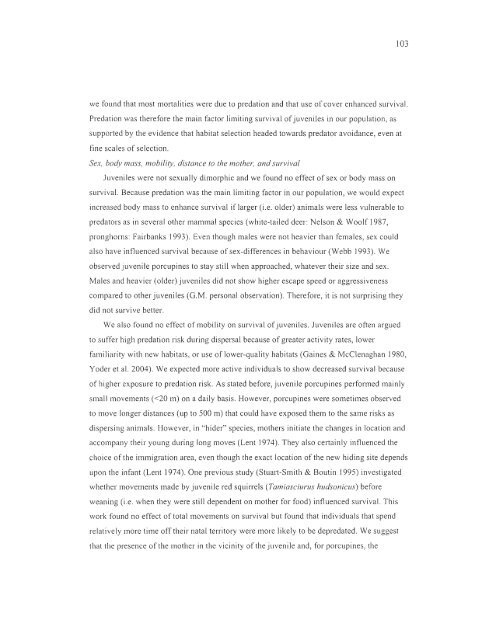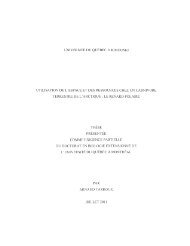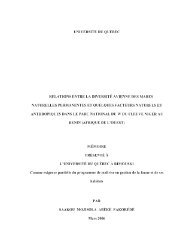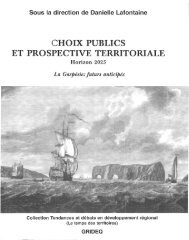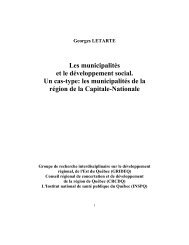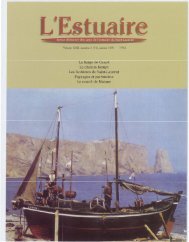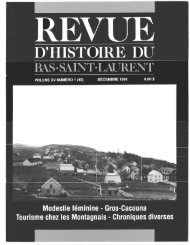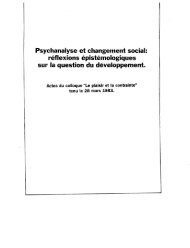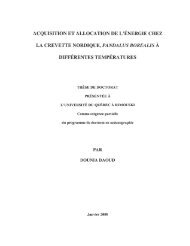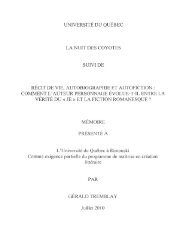influence du climat et de la prédation sur l'utilisation de l'habitat et la ...
influence du climat et de la prédation sur l'utilisation de l'habitat et la ...
influence du climat et de la prédation sur l'utilisation de l'habitat et la ...
You also want an ePaper? Increase the reach of your titles
YUMPU automatically turns print PDFs into web optimized ePapers that Google loves.
103<br />
we found that most mortalities were <strong>du</strong>e to predation and that use of coyer enhanced <strong>sur</strong>vival.<br />
Predation was therefore the main factor limiting <strong>sur</strong>vival of juveniles in our popu<strong>la</strong>tion, as<br />
supported by the evi<strong>de</strong>nce that habitat selection hea<strong>de</strong>d towards predator avoidance, even at<br />
fine scales of selection.<br />
Sex, body mass, mobility, distance ta the mother, and <strong>sur</strong>vival<br />
Juveniles were not sexually dimorphic and we found no effect ofsex or body mass on<br />
<strong>sur</strong>vival. Because predation was the main limiting factor in our popu<strong>la</strong>tion, we would expect<br />
increased body mass to enhance <strong>sur</strong>vival if <strong>la</strong>rger (i.e. ol<strong>de</strong>r) animaIs were less vulnerable to<br />
predators as in several other mammal species (white-tailed <strong>de</strong>er: Nelson & Woolf 1987,<br />
pronghorns: Fairbanks 1993). Even though males were not heavier than females, sex could<br />
also have intluenced <strong>sur</strong>vival because of sex-differences in behaviour (Webb 1993). We<br />
observed juvenile porcupines to stay still when approached, whatever their size and sex.<br />
Males and heavier (ol<strong>de</strong>r) juveniles did not show higher escape speed or aggressiveness<br />
compared to other juveniles (G.M. personal observation). Therefore, it is not <strong>sur</strong>prising they<br />
did not <strong>sur</strong>vive b<strong>et</strong>ter.<br />
We also found no effect of mobility on <strong>sur</strong>vival of juveniles. Juveniles are often argued<br />
to suffer high predation risk <strong>du</strong>ring dispersal because of greater activity rates, lower<br />
familiarity with new habitats, or use of lower-quality habitats (Gaines & McClenaghan 1980,<br />
Yo<strong>de</strong>r <strong>et</strong> al. 2004). We expected more active indivi<strong>du</strong>als to show <strong>de</strong>creased <strong>sur</strong>vival because<br />
of higher expo<strong>sur</strong>e to predation risk. As stated before, juvenile porcupines perfonned mainly<br />
small movements «20 m) on a daily basis. However, porcupines were som<strong>et</strong>imes observed<br />
to move longer distances (up to 500 m) that could have exposed them to the same risks as<br />
dispersing animaIs. However, in "hi<strong>de</strong>r" species, mothers initiate the changes in location and<br />
accompany their young <strong>du</strong>ring long moves (Lent 1974). They also ce11ainly intluenced the<br />
choice of the immigration area, even though the exact location of the new hiding site <strong>de</strong>pends<br />
upon the infant (Lent 1974). One previous study (Stuart-Smith & Boutin 1995) investigated<br />
wh<strong>et</strong>her movements ma<strong>de</strong> by juvenile red squirrels (Tamiasciurus hudsonicus) before<br />
weaning (i.e. wh en they were still <strong>de</strong>pen<strong>de</strong>nt on mother for food) intluenced <strong>sur</strong>vival. This<br />
work found no effect of total movements on <strong>sur</strong>vival but found that indivi<strong>du</strong>als that spend<br />
re<strong>la</strong>tively more time offtheir natal territory were more likely to be <strong>de</strong>predated. We suggest<br />
that the presence of the mother in the vicinity of the juvenile and, for porcupines, the


